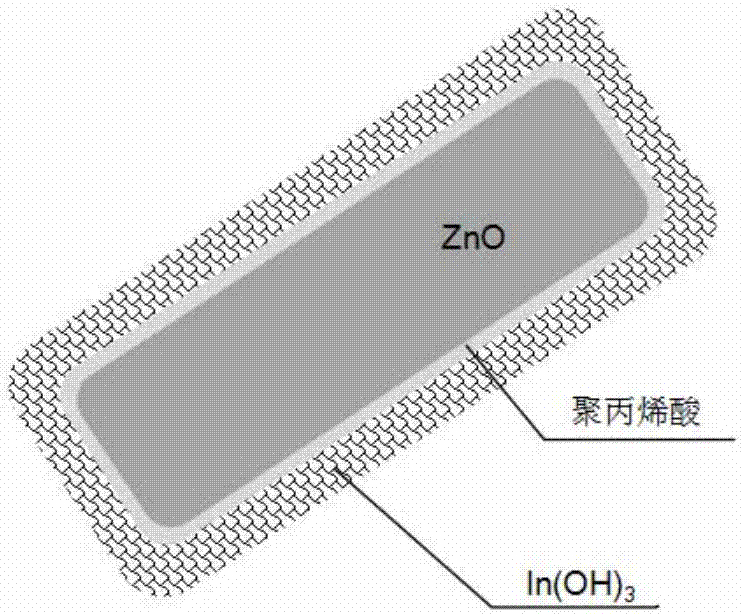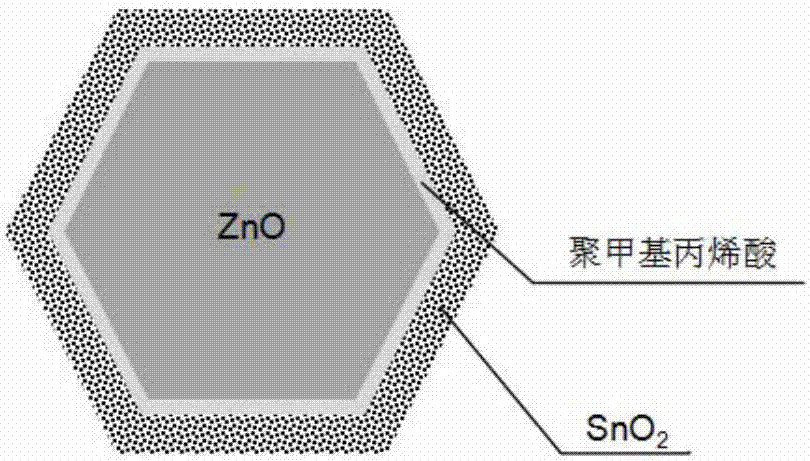Zinc oxide negative electrode material of zinc air cell and preparation method thereof
A zinc-air battery and negative electrode material technology, which is applied in the direction of battery electrodes, negative electrodes, active material electrodes, etc., can solve the problems of low zinc negative maximum current charging capacity, insufficient structural strength of the coating layer, and insufficient cycle life, etc., to achieve large Improved current charging capability, reduced concentration polarization, and extended cycle life
- Summary
- Abstract
- Description
- Claims
- Application Information
AI Technical Summary
Problems solved by technology
Method used
Image
Examples
Embodiment 1
[0036] Zinc oxide anode material: the thickness of the inner coating layer of polyacrylic acid is 5nm, and the thickness of the outer coating layer of indium hydroxide is 3nm.
[0037] Preparation of zinc oxide anode material: add 0.5 g of zinc oxide (with a particle size of 0.2-0.7 microns) to 50 ml of deionized water, ultrasonically disperse for 30 minutes, add 0.05 g of aminopropyltriethoxysilane, and stir for 5 hours at room temperature. After centrifugal separation, the product was washed alternately with ethanol and water three times, and dried in vacuum to obtain amino-functionalized zinc oxide. Then, add amino-functionalized zinc oxide to 250ml of 0.26mmol / L acrylic monomer solution, ultrasonically disperse for 10min and stir for 2h, add ammonium persulfate initiator containing 2wt% of polymer monomer and start at 80℃ Polymerization. After 4 hours of reaction, the product was centrifuged and washed alternately with ethanol and water three times to obtain zinc oxide coate...
Embodiment 2
[0041] Zinc oxide anode material: the thickness of the inner coating layer of polymethacrylic acid is 5nm, and the thickness of the outer coating layer of tin dioxide is 5nm.
[0042] Preparation of zinc oxide anode material: 1 g of zinc oxide was added to 100 ml of deionized water, ultrasonically dispersed for 30 minutes, 0.3 g of aminopropyltriethoxysilane was added, and stirred at room temperature for 4 hours. After centrifugal separation, the product was washed alternately with ethanol and water three times, and dried in vacuum to obtain amino-functionalized zinc oxide. Then, add 0.5g of amino-functionalized zinc oxide to 250ml of 0.26mmol / L methacrylic acid monomer solution, ultrasonically disperse for 10min and stir for 3h, add 1.5wt% ammonium persulfate initiator with polymer monomer At 65 。 C starts the polymerization reaction. After reacting for 7 hours, the product was centrifuged and washed alternately with ethanol and water three times to obtain zinc oxide coated wit...
Embodiment 3
[0045] Zinc oxide anode material: the thickness of the inner coating layer of acrylic acid methacrylic acid copolymer is 6nm, and the thickness of the outer coating layer of indium hydroxide is 10nm.
[0046] Preparation of zinc oxide anode material: add 0.5 g of zinc oxide to 50 ml of deionized water, ultrasonically disperse for 30 minutes, add 0.25 g of aminopropyltriethoxysilane, and stir for 3 hours at room temperature. After centrifugal separation, the product was washed alternately with ethanol and water three times, and dried in vacuum to obtain amino-functionalized zinc oxide. Then, the amino-functionalized zinc oxide was added to 250ml of 0.27mmol / L polymer monomer solution (acrylic acid monomer: methacrylic acid monomer molar ratio = 1:1), ultrasonically dispersed for 10 minutes and stirred for 2 hours, adding content The ammonium persulfate initiator, which is 3 wt% of the polymer monomer, starts the polymerization reaction at 85°C. After reacting for 5 hours, the pro...
PUM
| Property | Measurement | Unit |
|---|---|---|
| Thickness | aaaaa | aaaaa |
| Thickness | aaaaa | aaaaa |
| Thickness | aaaaa | aaaaa |
Abstract
Description
Claims
Application Information
 Login to View More
Login to View More - R&D
- Intellectual Property
- Life Sciences
- Materials
- Tech Scout
- Unparalleled Data Quality
- Higher Quality Content
- 60% Fewer Hallucinations
Browse by: Latest US Patents, China's latest patents, Technical Efficacy Thesaurus, Application Domain, Technology Topic, Popular Technical Reports.
© 2025 PatSnap. All rights reserved.Legal|Privacy policy|Modern Slavery Act Transparency Statement|Sitemap|About US| Contact US: help@patsnap.com



